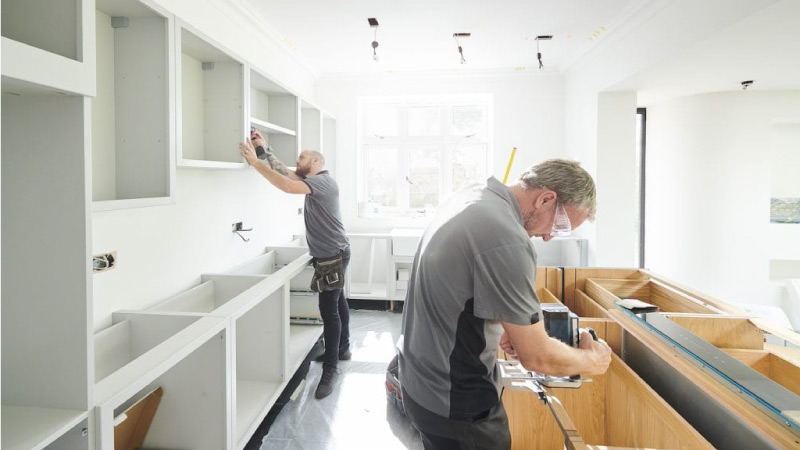Remodeling Your House? You Need This Step-By-Step Home Renovation Checklist
Remodeling and Renovation Tips

Turning your home remodeling ideas into reality? Whether you just bought a place that needs a lot of love or you’re finally able to do that makeover you’ve been dreaming about for years, this is a very big deal. But with all the details to keep straight and conversations to remember, a house makeover can quickly go off the rails. To help prevent that from happening — and to ensure you’ll see a potential return on your remodeling investment in the future — keep your home renovation ideas on budget and on track by using this step-by-step home remodeling checklist, developed with input from a seasoned remodeling pro.

What to Expect With a Home Remodeling Project
The following steps will guide you through a home remodeling project, but it helps to prepare for less technical things, as well — like the emotional toll a remodel can take.
Smaller tasks, like painting a room or giving your patio a makeover, may not be as stress-inducing, but to-dos that involve sheetrock can really rock your world.
Some home remodeling checklists may leave the mental health part out, but it’s important during what can be a stressful process. Here are some ways to keep things as zen as possible:
Know That Things Can and Will Go Wrong.
You can handle the ups and downs if you have a good plan and trusted resources.
Learn the Art of Compromise.
Rarely can anyone get everything they want out of a renovation. Limitations can include your home not being able to accommodate your wants or your budget not being able to accommodate them. There’s always middle ground, though, if you look for it.
Prepare To Move Out During the Renovations.
Notify Your Neighbors.
There’s going to be extra noise and extra people around your home. It’s courteous to let those who live beside you know about the disruption.
Have a Security Plan.
How will workers go in and out of your house? What happens when they leave every day? Ask yourself if it’s necessary to make extra sets of keys or rely on an alarm system.
What Are the Steps in a Home Renovation?
Each renovation project has its own specific steps, but one thing’s for sure across the board: Before any work actually starts, you’ll want to do plenty of research and preparation. Not taking the time to define your objectives, research contractors, compare prices on fixtures and features, collect design ideas, etc., can create longer timelines (which, in turn, results in a higher final bill).
It may sound like extra work, but it helps to list out all aspects of your renovation. Write down the steps, collect quotes and estimates, and save any important emails. Make a renovation file, document the process, and don’t forget to keep your eye on the prize.
Now, follow along as we break down our step-by-step home renovation checklist. Note that these steps are a general guide for handling a home renovation. Keep in mind, however, that every house is unique — as is every house project.
Q: What are the 5 stages of home renovation?
A: When creating step-by-step home renovation checklists, you’ll want to start by knowing the general outline of any home remodel. In a nutshell, the reno will start with an in-depth plan, so you have everything nailed down that you want to accomplish. Then, you’ll decide which parts you want to DIY and which parts you want to get professional help with. You’ll prep your home for the renovation by putting items in storage, making alternative living arrangements (or creating a temporary space within your home), and taking plenty of before photos (that’s the fun part). And then, you’ll simply get the ball rolling. The best stage? Celebrating that accomplishment when it’s all said and done, of course! For more details about each stage, keep reading!

Step 1: Plan Ahead for Your Home Remodel.
First on the home remodel list? We recommend following this four-step process: creating a plan, listing your priorities, setting a budget, and setting a deadline.
Create a Plan.
Every grand adventure begins with motivation and a map. Which room should you renovate first? That depends on your priorities. Do you have a necessary repair that you’ve been putting off? Are you finally ready to make that long-awaited update or improve the accessibility of an area? Once you’ve considered why you want to embark on your remodeling adventure — even if it’s just for fun — it’s time to plan how you’re going to get there.
List Your Must-Haves.
With your “why” nailed down, ask what your must-haves are. If grandma’s coming to live with you, a zero-entry shower could be non-negotiable. If you’re a private chef, that walk-in cooler is essential. Once you know what you can’t live without, you’ll have a better idea of where the wiggle room is in the budget.
Set a Budget.
Imagine having your roof ready for shingles and running out of money. Not a good place to be when a storm brews on the horizon.
“When I ask prospective clients their budgets, about 90% have no idea,” says Jay Gauldin, president of TBS Construction in the greater Roanoke Valley and Virginia Tech corridor of Virginia. If you’re unable or unwilling to finance this project, know your limit and keep a tight grip on the purse strings. Also, Gauldin recommends padding your budget with an extra 10 to 25 percent to cover unexpected surprises. He says to prepare for the unforeseen, like water damage found under tile, and for changes in plans, like you want a larger window than you first thought.
When preparing your home for sale, you definitely want to get back what you’ve invested. Use sites like HomeAdvisor to research an average cost when planning a remodeling project. Then check the Remodeling Impact Report published by the National Association of REALTORSⓇ (NAR) Research Group. Not only does it show the percentage of value normally recovered from a project, but it also includes a Joy Score — a number from 1 to 10 that rates how much enjoyment homeowners receive from a particular project.
If you’re not planning to sell your home, the Joy Score is still an important number to consider. After all, you don’t have to wait until you’re ready to move to enjoy new kitchen cabinets or a spa tub in the bathroom.
Set a Deadline.
If you’re working on a specific deadline, it’s important to have this date in mind when interviewing contractors to make sure they can fit you in their schedule. “The contractor should ask when you want the job completed,” says Gauldin, whose contracting company has earned a Best of Houzz Award six times. Even if you’re not in a hurry today, set a deadline. It’ll set the pace for the job and keep everything running smoothly.
When planning a remodeling project, remember there’s an order to things. Maybe the install guy can have his part done within the month, but the plumber is six weeks out. Use a calendar and plot each stage of the job to make sure everything fits together.
Q: What should you not forget when remodeling a kitchen?
A: There are plenty of important elements to remember when remodeling a kitchen — one of the most highly-trafficked spaces in many homes — but it’s always crucial to remember your budget. While it’s easy to be wooed by the pot filler faucets, below-counter wine fridges, and sprawling walk-in pantries, that can all cost some serious coin. Decide what’s most important to you and your lifestyle and prioritize that in your kitchen remodel. Also important? Lots of overhead and task lighting, so you can actually see what you’re cooking.

Step 2: Find Home Remodeling Inspiration.
With your budget in hand, dream about what your remodeled space will look like. Have you been to a home improvement store and looked at fixtures, floor coverings, or appliances? Do you know what your style is? Many design experts suggest starting on Pinterest.
Use the Pinterest search engine to look for things like “farmhouse-style kitchens” or “master suite designs.” This image-driven platform delivers photographs linked to websites that you collect and “Pin” to your own virtual bulletin board. Once you collect a few you like, study them for common themes or elements. They’ll help you and your contractor work together to achieve the look of your dreams.
Remember, though, that pictures can be deceiving. It helps to see design in person, too, to know how it’ll actually feel and look in real life (Instagram vs. Reality). If you admire any of your friends’ homes, ask them if you can take some pictures to send to your contractor. Imitation is the sincerest form of flattery, after all.

Step 3: Research and Hire Professional Help.
Once you’ve put your dreams on paper, it’s time to look for someone to make them come true. But before you start looking for your home remodeling soulmate, ask yourself which, if any, aspects of this job you can tackle yourself.
According to NAR’s 2023 Remodeling Impact Report, 13 percent of homeowners contributed some do-it-yourself (DIY) labor to their projects. If this describes you, you’ll want to find a contractor willing to work with and around a DIYer.
The report also showed that 40 percent did the project themselves, 37 percent hired a professional for the entire job, and 10 percent hired the labor but purchased the materials.
DIY Kitchen Renovation Checklist / Bathroom Renovation Checklist
- Switch out the cabinet knobs and pulls with more modern ones
- Paint the cabinets and walls
- Install floating flooring over your existing flooring
- Update the light fixtures (if you feel comfortable doing that, of course)
Ask for Referrals.
Did your friend recently remodel her kitchen? Ask her who did the job. What about your neighbor or co-worker? “Most of our leads come from previous customers,” says Gauldin. If you can’t find someone through people you know, check out the listings on places like HomeAdvisor or the NARI website. Social media groups are also great sources for local references.
Check Reviews and Credentials.
Also, find out if your contractor is licensed for the scope of your project and if they’re insured. Gauldin recommends checking your state’s licensing page online. There, he says, you can find out if they have the proper certifications and if they’ve ever been fined. Use the information you uncovered to pare down your list to two or three contractors you’d like to interview.
Request Estimates.
Contact two to three choices for estimates. “An estimate will require a site visit,” says Gauldin, “which may or may not include subcontractors.” They should take lots of photos and measurements and then send you a sketch to approve. “It’s the contractor’s interpretation of what the homeowner wants,” he says. Once you approve the sketch, he can bid for the job. “It can take three to six weeks from first visit to quote in hand,” Gauldin says.Ask Questions.
It’s a scary proposition to invite a perfect stranger into your home to essentially tear it apart and put it back together again. In addition to checking your contractor’s references, licenses, and insurance information, you want to ask about permits, inspections, how many people to expect in your house, and how to get in touch with them. See our list of key questions to ask a building contractor.
Hire Someone.

Step 4: Prepare for the Home Remodeling.
The next step in the home reno checklist is to help things get off to a good start by preparing the space for your remodeling job. You don’t want workers arriving bright and early Monday morning to find the kitchen cabinets they’re removing full of dishes. You also don’t want your belongings damaged or covered with dust and debris.
Rent a Portable Storage Container.
A lot of people work on one area of their home at a time, so they can continue living in the house while the remodel is going on. But how do you renovate one room at a time without having stuff everywhere? Consider renting a PODS portable storage container to protect your belongings while keeping them close by. With the container delivered right to your driveway, there’s no need to rent a truck to haul everything across town. And, if you need something mid-project, just go out to the container and retrieve it any time you want.
Make Living Arrangements.
Will you survive without the use of your jetted tub during your primary bathroom remodel? Or while your kitchen is getting an overhaul, can you make do with a microwave in the laundry room? There are ways to create a temporary living space within your own home, but if that’s not your cup of tea, you’ll need to make other arrangements. It may sound silly, but things happen. Timelines get stretched. It’s best to think about this on the front-end.
Take “Before” Photos.
Major home remodels deserve documenting. Don’t forget to take photos before you start the demolition process.

Step 5: Make the Transformation.
You’ve hired your contractor and signed on the dotted line. Now it’s time to begin the transformation from old to new. And when it comes to actually getting it done, there are a few things that’ll help put the wind in your sails.
Be Available.
Make sure your contractor and principal subs have your contact information. Check the work regularly to halt any mistakes or miscommunications before things get too far.
Be Patient.
Delays happen. It rains, for days on end. Trucks break down, with your order inside. Employees get sick, even those on your crew. When you expect delays to happen, and have a good attitude when they do, it makes the job more joyful for everyone.
Make a Punch List.
Q: In what order do you redo a room?
A: If you’re remodeling a room in your home, start with the ceiling. Let all of that messy material fall onto the floor, then remove your flooring. After that, strip the walls and remove cabinets and/or countertops (if applicable). Then focus on any electrical or plumbing needs. Once the groundwork is done, prep and paint walls, repair and paint the trim, and install new flooring. Then, move your countertops, cabinets, appliances, and other fixtures in place.
Step 6: Celebrate Your Accomplishment!
For more home remodeling tips and resources, check out the PODS Blog.
Carol J. Alexander writes about home remodeling and lifestyle topics from her home in the Shenandoah Valley of Virginia. Her work has appeared in This Old House, Family Handyman, and Farmer’s Almanac.

Your quote in 60 seconds
Get pricing tailored to your needs!








